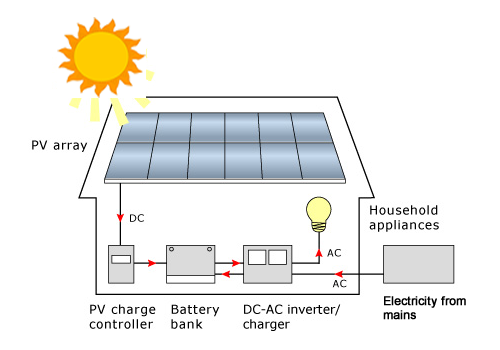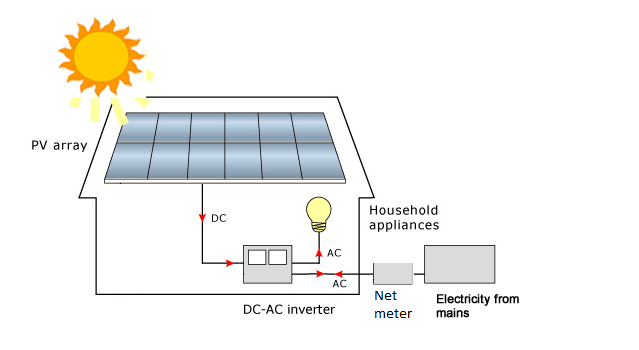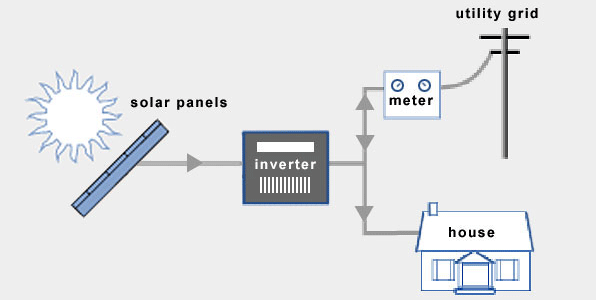1) Off grid system
The term off-grid refers to not being connected to a grid, mainly used in terms of not being connected to the main or national electrical grid. In electricity, off-grid can be stand-alone systems (SHS) or mini-grids typically to provide a smaller community with electricity. Off-grid electrification is an approach to access electricity used in countries and areas with little access to electricity, due to scattered or distant population. It can be any kind of electricity generation. The term off-the-grid (OTG) can refer to living in a self-sufficient manner without reliance on one or more public utilities.
Off-the-grid homes are autonomous; they do not rely on municipal water supply, sewer, natural gas, electrical power grid, or similar utility services. A true off-grid house is able to operate completely independently of all traditional public utility services.

2) Grid-tie system
A grid-tie inverter is a power inverter that converts direct current (DC) electricity into alternating current (AC) with an ability to synchronize to interface with a utility line. Its applications are converting DC sources such as solar panels into AC for tying with the grid.
Inverters take DC power and invert it to AC power so it can be fed into the electric utility company grid. The grid tie inverter must synchronize its frequency with that of the grid (e.g. 50 or 60 Hz) using a local oscillator and limit the voltage to no higher than the grid voltage. The inverter has an on-board computer which will sense the current AC grid waveform, and output a voltage to correspond with the grid. However, supplying reactive power to the grid might be necessary to keep the voltage in the local grid inside allowed limitations. Otherwise, in a grid segment with considerable power from renewable sources voltage levels might rise too much at times of high production.
Grid-tie inverters are also designed to quickly disconnect from the grid if the utility grid goes down. The grid tie inverter will shut down to prevent the energy it transfers from harming any line workers who are sent to fix the power grid.
Properly configured, a grid tie inverter enables a home owner to use an alternative power generation system like solar or wind power without extensive rewiring and without batteries. If the alternative power being produced is insufficient, the deficit will be sourced from the electricity grid.

3) Net metering system
Net metering allows residential and commercial customers who generate their own electricity from solar power to feed electricity they do not use back into the grid.
Net metering is a billing mechanism that credits solar energy system owners for the electricity they add to the grid. EDL is offering the installation of the Net metering free of cost. For example, if a residential customer has a PV system on the home’s rooftop, it may generate more electricity than the home uses during daylight hours. If the home is net-metered, the electricity meter will run backwards to provide a credit against what electricity is consumed at night or other periods where the home’s electricity use exceeds the system’s output. Customers are only billed for their “net” energy use. On average, only 20-40% of a solar energy system’s output ever goes into the grid. Exported solar electricity serves nearby customers’ loads.
Residences and businesses that have a grid-tied electrical system or off grid system are permitted in Lebanon to sell their energy to the utility grid. Electricity delivered to the grid can be compensated in several ways. “Net metering” is where the entity that owns the renewable energy power source receives compensation from the utility for its net outflow of power. So for example, if during a given month a power system feeds 500 kilowatt-hours into the grid and uses 100 kilowatt-hours from the grid, it would receive compensation for 400 kilowatt-hours. In the US, net metering policies vary by jurisdiction. Another policy is a feed-in tariff, where the producer is paid for every kilowatt hour delivered to the grid by a special tariff based on a contract with distribution company or other power authority.

